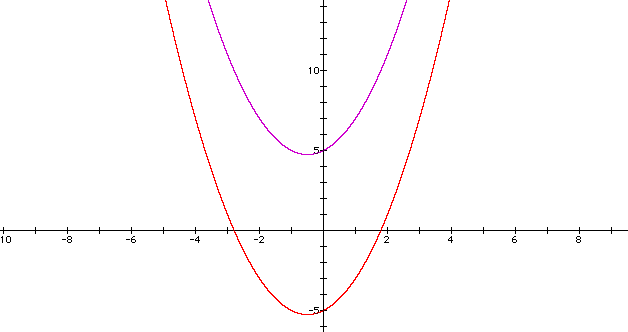Construct graphs for the parabola
for different values of a, b and c. (a , b and c can be any rational numbers)
I begin with the simplest type of quadratic function,
This gives me a parabola with vertex (0,0). if a > 0, the vertex is the point with the minimum y-value on the graph. If a < 0, the vertex is the point with the maximum y-value on the graph. We note that y=-ax is a mirror image of y=ax about thr x-axis for the same values of a.
Sketching of Quadratic Functions
Let us compare the following graphs:
We notice that with greater values of a, the graph shrinks by a factor a, creating a narrower parabola.
If a < 0 , the parabola opens more widely with smaller values of a. Hence, we conclude that the coefficient of a determines how widely the parabola
![]() opens.
opens.
Investigating c
Next, I investigate how the various values of c affect the shape of
where c can take any rational numbers. From my observations, the point where the parabolas cut the y-axis will be (0,c). the point (0,c) is not the vertex of the parabola. Let a =1 and b = 1. We then have,
We construct this parabola using c =-6,-4,-2,0,2,4,6.
We obeserve that the parabola
cuts the y-axis at (0,c).
The parabola
cuts the y-axis at (0,-c). This point is however not the vertex.
Investigating b
I investigated the movement of the parabola
of the general form ![]() .
.
I discovered that the movement of the parabola traced another parabola of the form
Next, I investigate what happens when 2
parabolas of the form ![]() overlay/intercept. I set a = 1 or -1 and c = -5,
5.
overlay/intercept. I set a = 1 or -1 and c = -5,
5.
Summary of Results
Case 1
The 2 graphs intercept at 2 points. One of the points is (0,5) for all values of n. When x=0, the 2 graphs has one point of intersection at (0,5). The area of intersection is greater for greater values of n. The graphs move together for the same values of n. When n> 0, graphs move along the positive x-axis. When n<0, the graph moves along the negative x-axis. the following pairs of parabolas produce the same kind of interceptions.

Case 2
![]()

The 2 parabolas intercept at at only 1 point (0,5) for all values of n and they are symmetrical about the point (0,5). They move in opposite directions for the same values of n. The pairs of parabolas that produce similiar interception patterns are
Case 3

Most of the pairs of parabolas intercept in the above manner.
Case 4
The 2 parabolas never neet and they move together.

Other pairs of parabola that intercept in the same manner is
If we put a is negative, the above set of parabolas still move together but with the cup facing downwards.
The vertex of a parabola of the form
is obtained when
Then,
Roots of Parabola
The solutions of a quadratic equation in
the general for![]() are
given by
are
given by
To find the total number of roots, we follow the following rules:
If the discriminant is ![]()
(1) Positive
The quadratic equation has 2 distict real solutions and its graph has 2 x-intercepts
(2) Zero
The quadratic equation has one repeated real solution and its graph has 1 x-intercpet
(3) Negative
The quadratic equation has no real solution and its graph has no x-intercpets. Its square root is imaginary and yields 2 complex solutions
Test out the discriminant rule in assignment 3 to find out the behaviour of the roots.